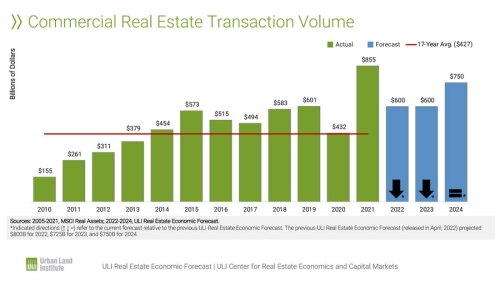Economists see a pretty good year ahead for real estate, despite a weak world economy.
“The data [are] good, but we all feel this uncertainty,” said Jeffrey Havsy, chief economist, Americas, CBRE Econometric Advisors. He spoke at a panel discussion of the semiannual Urban Land Institute (ULI) Real Estate Consensus Forecast, as part of a webinar held online on April 6.
Several panelists called it a “Goldilocks forecast,” saying the U.S. economy seems to be neither too hot or nor too cold. The interlocking pieces of the larger economy—job growth, inflation, and interest rates—seem balanced, taking some pressure off central bankers to raise or lower interest rates.
The forecast also did not threaten serious shocks to the real estate business.
Price growth for real estate properties, income growth from properties, and yields for investors are all anticipated to be strong over the next three years, although not quite as strong as in the recent past, according to Consensus Forecast, which is based on a survey of 48 of the industry’s top economists and analysts.
ULI’s online audience agreed with the forecast, according to a survey of the people who listened to the webinar presentation of the Consensus Forecast and the panel discussion that followed. Sixty-five percent of the audience felt that the forecast was “just right,” while 26 percent thought it was “too optimistic,” and only 9 percent thought it was “not optimistic enough.”
Jobs and GDP
The forecast still shows strong growth for the U.S. gross domestic product (GDP) and employment, but not as strong as in the last forecast. The GDP will grow 2.2 percent this year and average the same rate over the next three years, according to the forecast. That is down 60 basis points from the forecast of six months ago and 80 basis points from the forecast of one year ago.
The economy should continue to create new jobs at a rate of a net 2 million a year through 2018, according to the forecast. That is higher than the historical average of 1.2 million a year, but it is down sharply from 2.7 million in the previous forecast. It is also much less than the actual job growth of 3.0 million and 2.7 million in 2014 and 2015, respectively.
The forecast for job growth could seem low compared with the relatively strong growth in GDP. “This appears to be quite a pessimistic forecast,” said Mary Ludgin, managing director for Heitman. However, job growth is restrained by the number of workers available to do those jobs. The unemployment rate is also expected to fall to 4.8 percent before the end of 2016 to reach 4.7 percent by the end of 2017.
“You can’t have 2 percent job growth and 1 percent population growth for too long,” Havsy said. As the economy approaches full employment, inflation is finally expected to rise to 1.6 percent in 2016 and to 2.0 percent in 2017 and 2018.
Interest Rates
The forecast for interest rates may be the best example of the middling forecast. Six months ago, it seemed likely that the Federal Reserve might raise its benchmark interest rates several times in 2016. However, the pace of increases seems to have stalled after the first increase of 25 basis points at the end of 2015.
The forecast certainly does not seem to include much more Fed action. The yield on the ten-year U.S. Treasury note is forecast to rise gradually over the next three years—to 2.4 percent in 2016 (about where the yield actually was in 2015), 2.8 percent in 2017, and 3.2 percent in 2018. The new 2016 and 2017 forecasts are 40 and 50 basis points lower, respectively, than the forecast of six months ago. It is worth noting that futures markets expect even lower interest rates than even this lowered forecast.
Commercial Real Estate Stays Strong
Higher interest rates should mean higher yields for commercial real estate—which means lower prices for properties relative to the income derived from them. However, prices are still anticipated to rise, just more slowly than real estate experts have gotten used to.
“We’ve had six years of double-digit returns,” Peyton said. “The market has been very good to investors.” The NCREIF Property Index (core unleveraged properties) total returns should average 7.5 percent, below the long-term trend of 10.2 percent. The 2016 forecast of 8.1 percent is down from 9.0 percent last September and below the Pension Real Estate Association (PREA) Consensus Forecast of 8.5 percent.
The capitalization rates recorded by the National Council of Real Estate Investment Fiduciaries are expected to rise, but very slowly. Cap rates will stay at the same level as last year, 5.1 percent, in 2016, rising to 5.5 percent by 2018, according to the forecast. (Cap rates represent the income from property as a percentage of the sale price.)
“I focus on the lag between interest rates and how they affect the economy and how they affect real estate,” said Martha Peyton, managing director, TIAA-CREF. “It takes an awful long time.”
Prices for commercial real estate will rise much more slowly, according to the forecast. The Moody’s/Real Capital Analytics Index is forecast to rise by 3.6 percent per year over the next three years, compared with a long-term average increase of 5.8 percent. That is a tiny increase compared to the actual 12.7 percent increase in 2015. It is also less than the previous Consensus Forecast, 6.0 percent growth in 2016 and 4.5 percent in 2017.
Fewer properties will trade hands in 2016, gradually falling to $475 billion in 2018, according to the forecast. That is down from $534 billion in actual sales in 2015, which the economists forecast will prove to be the peak year for the volume of sales before the decline to come.
Upside Surprise?
However, the U.S. real estate market could still outperform. “The transaction volumes were way too pessimistic,” Ludgin said. That is because international investors are likely to steer even more money into real estate in the United States as the economies of China and Europe slow down.
“If you look at the alternative destinations for global capital, our position has become even more attractive,” Peyton said. International capital could even help keep cap rates low—or, surprisingly, push them even lower. “There may be some room for greater cap-rate compression.”
Fundamentals for U.S. real estate continue to be relatively strong. Surprisingly, forecasts for office and apartment rent growth are higher than they were six months ago, with the other three property types looking less robust, though still positive. Rents or revenue per available room are expected to grow 3.4 to 3.6 percent on average for 2016–2018 for the warehouse, office, and hotel sectors.
On the downside, however, few economists seem to factor a real risk of recession into their forecast; but even if the U.S. economy suffers an unexpected downturn, real estate seems to be in a relatively strong position.
“Even if some black-swan event creates a recession, we would weather it relatively well,” said Peyton.



